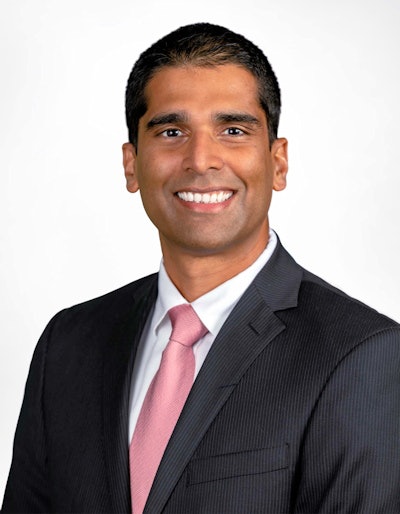
The radiology report is a key element of the service that radiology groups provide to referring physicians. In fact, many see the report as a radiology group's single most important deliverable to customers -- and it may need to change in years to come.
But radiology reports are sometimes structured more to the liking of the radiologist doing the reporting than to the needs of the referring physician who's receiving it. Some medical specialties like more detail in their reports than others, while almost everyone seems to prefer a more structured format.
So what do referring physicians really want from a radiology report? There's a chance that it may differ greatly from what's being sent to them by their radiology group. One imaging services provider set out to change that.
Creating a better radiology report
National radiology group Radiology Partners (RP) launched an initiative to produce report formats that reflect the preferences of its referring-physician customers.
 Dr. Krishna Nallamshetty, chief medical officer of Radiology Partners.
Dr. Krishna Nallamshetty, chief medical officer of Radiology Partners.After conducting a survey of nearly 600 referring physicians, the company's Clinical Value Team (CVT) has developed 125 radiology report templates based on the feedback the team received. The CVT is now in the process of deploying the templates for use by RP's approximately 3,500 radiologists.
The project began in 2021 as part of an effort to focus on service to the group's referring clinicians, said RP's Chief Medical Officer Dr. Krishna Nallamshetty.
Historically, radiology reports have been created based on what radiologists think the referring physician or surgeon would want, Nallamshetty said. There's also been much debate in radiology on the value of shifting toward structured reporting.
Rather than deciding unilaterally on the report format, RP developed a survey to gain insight into what its referring physicians consider to be the key elements of report design. First, the group gathered opinions from radiologists practicing in different environments to ascertain what they thought was important to include in a radiology report.
Next, the team developed three sample report styles that radiologists frequently use. Each of the reports contained the same clinical information, including findings and impression, but was presented in different formats with varying levels of detail and structure. These sample reports were then presented in a survey to 584 referring physicians from multiple specialties and various settings around the country. The survey also included advanced practice providers.
The respondents were then asked for their preferences and for the reasoning behind their choices. For each of the report types, physicians were asked to rate overall appearance and formatting, as well as satisfaction with the level of detail on a scale of 1 to 5 (best).
The most popular style, Report 2, featured a uniform structure and a medium level of detail.
| Referring physician preference for more structured reports | |||
| Report Style 3 | Report Style 1 | Report Style 2 | |
| Overall appearance and formatting | 3.3 | 3.7 | 4.3 |
| Satisfaction with level of detail | 3.1 | 3.9 | 4.5 |
Overall, the physician respondents preferred some uniform structure in their reports, Nallamshetty noted.
"Rather than having every radiologist dictate and report something completely differently, [respondents] thought that this was very efficient for them to find the information that they want," he said.
Next, the Radiology Partners team wanted consistency in how findings were reported by categories. For example, the team wanted information that was grouped by organ, Nallamshetty said.
"So if I'm a surgeon who's interested in the pancreas, it's very easy for me to find the pancreas section and read all of the detail that was provided in that section," he explained. "So that consistency was important."
Also, the preferred level of detail was directly correlated with the specialty of the referring physician, Nallamshetty noted. An emergency room physician or a trauma physician wants to see what is normal and get the positive finding in the report. That enables them to quickly get to the findings that they need to triage and take care of quickly, he said.
"But then if you look at other specialties -- especially the medical and more surgical specialties -- they wanted a lot more detail," he said. "They wanted information about what was present and what was not present and all of that relevant background."
Although the preference for level of detail varied by specialty, it did not correlate with the number of years the physicians were in practice, RP found. The respondents also tended to prefer that standard required fields, such as contrast dose and dose reduction, be placed in the technique section rather than at the end of the report.
While not everybody favored the most popular report format, most of the respondents indicated that they preferred concise language, minimal narrative, and actionable information upfront, according to the company.
In other findings, 67% preferred that journal citations be included in the report when recommendations were made, while 33% did not.
"So that if they wanted to go ahead and dive deeper, they had a resource to be able to do that," Nallamshetty added.
Developing new templates
The Clinical Value Team then presented the data to the leadership teams for RP's eight national subspecialty divisions. Next, the CVT began an effort to create best-in-class reporting templates for each specialty based on the feedback received from the referring physicians in the survey.
The group also ensured that all of its reports captured all the quality measurements needed for the Medicare Access and CHIP Reauthorization Act's (MACRA) Quality Payment Program (QPP) and Merit-Based Incentive Payment System (MIPS).
Ultimately, the team created approximately 125 reporting templates, which would cover about 85% of RP's total imaging volume. The templates were then built into RP's dictation platforms.
Change management
Of course, it can be challenging to convince radiologists to change how they report. A critical factor in the change-management process is showing the radiologists the survey data, Nallamshetty said.
"I think for the first time that people realize ... if my job is here to create a report that is designed to help them perform their jobs, then maybe it's worth taking a little bit of time to restructure how I cater to them," he added.
The CVT is now working with individual RP practices on a one-on-one basis to implement and integrate the templates into their workflow, according to Nallamshetty. Radiologists can immediately begin dictating reports using the templates.
The next step will be to make the reports more specific for each specialty.
"We thought that if an emergency room case comes up on the list to report, a completely different template would show up," he said. "Because their level of detail is very different than, let's say, an oncologist."
In the third phase, RP will look at developing reports geared toward specific providers.
"The thing that we have to balance is that we can't have 10,000 physicians each with their own different [report]," he said. "So that's why we wanted to start with the specialty first, thinking that it may solve that problem, and then determine what the need is to go even deeper [in terms of customization]."
Current status
New radiologists joining RP automatically gain access to the templates on the company's systems, and current groups are going through a conversion process to use the templates.
Radiologists have the choice of whether or not to use the templates, Nallamshetty said.
"Our role is to provide the radiologists with the resource and with all of the information to make the decision as to what's best for them," he said. "The local dynamics are going to drive what's best at that local site."
The report templates also contain hidden watermarks to track utilization of the reports, he added.
The CVT is working to ensure that the templates also benefit the radiologists themselves, Nallamshetty explained.
"They already see the benefit that the referring physicians like [the templates] better, but now we have to show the radiologists that the templates actually make them better in their daily performance," he concluded.




















